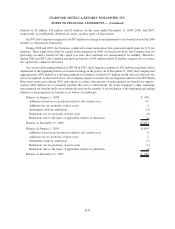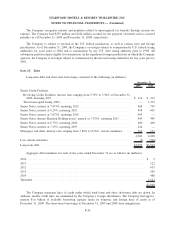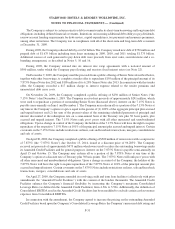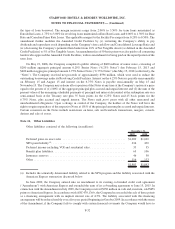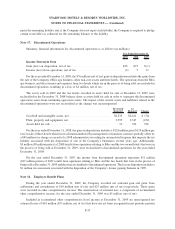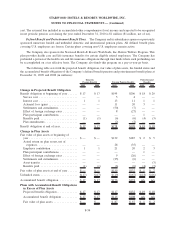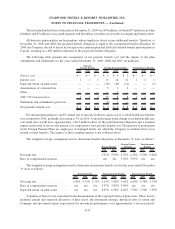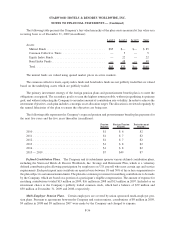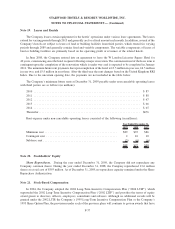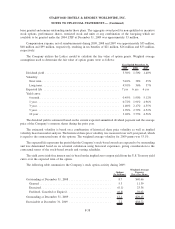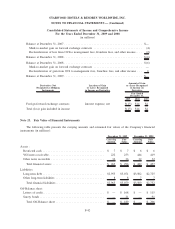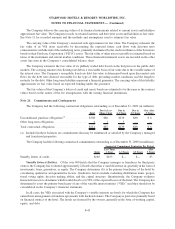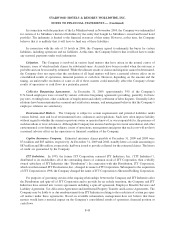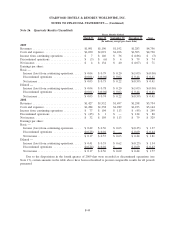Starwood 2009 Annual Report Download - page 162
Download and view the complete annual report
Please find page 162 of the 2009 Starwood annual report below. You can navigate through the pages in the report by either clicking on the pages listed below, or by using the keyword search tool below to find specific information within the annual report.
The weighted-average fair value per option for options granted during 2009, 2008 and 2007 was $4.69, $17.24
and $20.54, respectively, and the service period is typically four years. The total intrinsic value of options exercised
during 2009, 2008 and 2007 was approximately $1 million, $89 million and $187 million, respectively, resulting in
tax benefits of approximately $0.3 million, $35 million and $56 million, respectively. As of December 31, 2009,
there was approximately $24 million of unrecognized compensation cost, net of estimated forfeitures, related to
nonvested options, which is expected to be recognized over a weighted-average period of 2.94 years on a straight-
line basis.
The aggregate intrinsic value of outstanding options as of December 31, 2009 was $161 million. The aggregate
intrinsic value of exercisable options as of December 31, 2009 was $34 million. The weighted-average contractual
life was 4.74 years for outstanding options and 2.98 years for exercisable option as of December 31, 2009.
The Company recognizes compensation expense equal to the fair market value of the stock on the date of grant
for restricted stock and unit grants over the service period. The service period is typically three or four years except
in the case of restricted stock and units issued in lieu of a portion of an annual cash bonus where the restriction lapse
period is typically in equal installments over a two year period.
At December 31, 2009, there was approximately $105 million (net of estimated forfeitures) in unamortized
compensation cost related to restricted stock and units. The weighted average remaining term was 1.94 years for
restricted stock and units outstanding at December 31, 2009. The fair value of restricted stock and units for which
the restrictions lapsed during 2009 was $33 million.
The following table summarizes the Company’s restricted stock and units activity during 2009:
Number of
Restricted
Stock and Units
(In millions)
Weighted Average
Grant Date Value
Per Share
Outstanding at December 31, 2008 ........................ 5.4 $52.05
Granted .......................................... 5.3 $11.15
Lapse of restrictions ................................. (2.0) $44.94
Forfeited or Canceled ................................ (0.7) $32.78
Outstanding at December 31, 2009 ........................ 8.0 $28.48
2002 Employee Stock Purchase Plan
In April 2002, the Board of Directors adopted (and in May 2002 the shareholders approved) the Company’s
2002 Employee Stock Purchase Plan (the “ESPP”) to provide employees of the Company with an opportunity to
purchase shares through payroll deductions and reserved 10,000,000 shares for issuance under the ESPP. The ESPP
commenced in October 2002.
All full-time regular employees who have completed 30 days of continuous service and who are employed by
the Company on U.S. payrolls are eligible to participate in the ESPP. Eligible employees may contribute up to 20%
of their total cash compensation to the ESPP. Amounts withheld are applied at the end of every three month
accumulation period to purchase shares. The value of the shares (determined as of the beginning of the offering
period) that may be purchased by any participant in a calendar year is limited to $25,000. The purchase price to
employees is equal to 95% of the fair market value of shares on the date of purchase. Participants may withdraw
their contributions at any time before shares are purchased.
Approximately 265,000 shares were issued under the ESPP during the year ended December 31, 2009 at
purchase prices ranging from $11.01 to $30.42. Approximately 200,000 shares were issued under the ESPP during
the year ended December 31, 2008 at purchase prices ranging from $16.02 to $45.98.
F-39
STARWOOD HOTELS & RESORTS WORLDWIDE, INC.
NOTES TO FINANCIAL STATEMENTS — (Continued)


